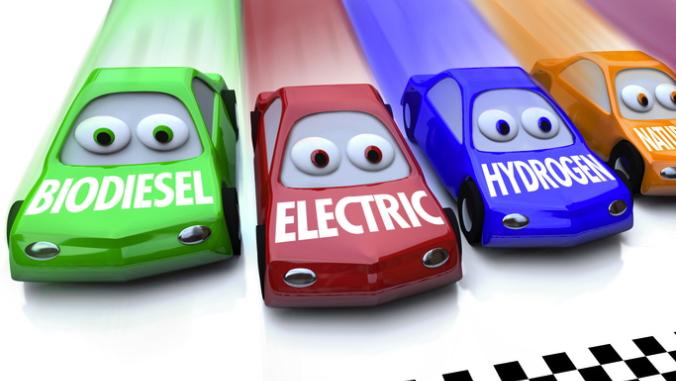Cap-and-Trade Called a 'Silver Bullet'
In this ClimateBiz.com Q&A, Miriam Horn, co-author of "EARTH: The Sequel," describes some of today's emerging cleantech innovators and the reasons they need a cap-and-trade to help bring their technologies to scale.

Now out in paperback, the book, which is the subject of a recent Discovery Channel documentary, makes the case for why a greenhouse gas cap-and-trade system is the "silver bullet" needed to unleash these technologies at the scale and speed required to address climate change.
 |
I caught up with Miriam Horn to talk about some of the innovations spotlighted in the book -- including solar paint or tapping geothermal power to keep an Alaskan ice hotel from melting -- and discuss the ways in which businesses should position themselves ahead of a cap-and-trade program.
Tilde Herrera: Miriam, tell me a little bit about the genesis of the book.
Miriam Horn: Well, it was really Fred’s idea. It came from two origins. One was his recognition that the greatest resistance to action on climate legislation was the fear that it was going to be nothing but a giant economic burden and that it was going cost American jobs and compromise our competitiveness around the world.
Fred was out in the world seeing a totally different story. He spends a lot of time with John Doerr (and) venture capitalists that are heavily invested in this next generation energy technology, and what he was hearing from them was the opposite story: This was going to be the economic engine of the coming century and that, in fact, what was really compromising American competitiveness was the fact that we weren’t diving deep into these technologies. A lot of European companies and, more recently, Asian companies were getting well ahead of us in solar technologies, wind, marine energy and most of the really important new generation technologies because they already had economic incentives in place.
The absence of those in the U.S. and this kind of hidden subsidy for fossil fuels in the form of the free right to dump carbon in the atmosphere meant that we were sort of lolling along and falling further and further behind. So he wanted to give people a glimpse of what he had the fortune to see very early on.
 |
He had been in Iceland and learned there about this amazing geothermal innovator in Alaska, this guy Bernie Karl who wanted to keep his ice hotel frozen and so he figured out how to use his low temperature geothermal resource to make electricity. Everywhere Fred went it seemed like he heard another one of these stories.
TH: I’m sure it’s hard to choose one, but can you offer an example of a company that really illustrates both that innovative spirit and incredible near-term potential?
MH: Sure. Let me tell you about two companies, if I can. One is a Fortune 500 company, United Technologies (UTC). I just mentioned this low temperature geothermal power plant that was developed up in Chena, Alaska. It’s in the middle of nowhere, really, and it’s off the grid. Bernie Karl, the guy who owns it, he built this ice hotel and was spending about $1,000 a day on diesel trying to keep the thing refrigerated. He actually failed and the whole thing melted. Forbes called it the dumbest business idea of the year.
He decided to build it again -- which was sort of Bernie’s way -- but this time he hired a couple engineers to figure out how to convert (what is) really just warm water. His hot springs are only about 140 degrees, which all the experts said simply wasn’t hot enough to first make refrigeration and then make electricity. They all said, “You can’t do it.”
 |
So he did, and he did it with the help of United Technologies, which is pretty remarkable that this Fortune 500 company that has hundreds of thousand of employees was willing to step in and work with this eccentric guy in the Alaskan frontier to develop this technology, but they did and they now are commercializing it.
I was actually just out at their headquarters in Connecticut looking at the latest version of it. It’s just this beautiful little power plant that you can take to any low temperature heat resource, so one of the places they’ve been piloting it is in Texas at oil wells. When you drill for oil, you’re down in that deep hot rock and a lot of water comes out, too. Oil companies spend a lot of money to separate that water out and throw it away.
If they bring one of these little UTC power plants down there they can turn that hot water into electricity and power all their operations. So, that’s one company you would think might be too stodgy, but a lot of the Fortune 500 companies are figuring out a way to wade in.
More of what we focus on in the book are the startups and one of my favorites is a company called Innovalight in Silicon Valley. They are working on a really low-cost way to make solar cells.
There’s a lot of competition in what’s called thin film solar technology, which is moving away from growing wafers and sawing wafers and these big costs for installing those on the roof, and instead moving towards a very thin, very flexible solar cell, which is cheaper because it uses a lot less materials and you can produce them in high volume.
What Innovalight is doing, which is different from any other thin film company, is they are using silicon but figuring out a way to use unpurified silicon. Right now solar cell makers compete with microchip makers for silicon wafers and that drives up the price. So Conrad Burke, who’s the CEO, and his team have figured out how to dissolve silicon nanoparticles into an ink and then they can print that ink. Using an industrial printer they can print that ink right on to whatever foil substrate they want, and ultimately, they’ll be able to integrate that solar foil right into the building materials so you won’t have to put the solar system up on the roof. It will be your roof potentially. There are people even working on solar paint.
(Innovalight) actually just launched their first small-scale plant in January. In the midst of this incredible downturn they still managed to launch their plant and are plowing ahead. They also have this remarkable achievement, at least in the lab, that everyone has been trying to get to in solar technology.
When a photon, a particle of light comes in, it has a lot of energy and enough energy theoretically to knock a bunch of electrons loose but no one’s ever been able to get it to do that.
Now in solar technology, you get one photon, one electron, and the rest of that solar energy gets thrown away. Innovalight has actually been able to get multiple excitons, as they call it, to actually capture a lot more of each photon’s energy. If they can transfer that into the commercial product they will have a solar cell that is vastly more efficient than anything on the market right now.
TH: So, in the book, there’s a passage where it mentions a cap-and-trade being a silver bullet to launch all of these technologies into the mainstream. Do you think that a cap-and-trade is a foregone conclusion and do you think that these sorts of technologies can be unleashed under a carbon tax?
MH: Well, there are a number of problems with a carbon tax but the biggest one, in terms of incentivizing technologies, is that there isn’t a way for capital to flow easily to these solutions. With a cap-and-trade mechanism, if you’re a power producer that deploys these carbon-free geothermal power plants in a carbon-constrained economy, a lot of money is going to flow your way quickly because people are going to be rushing to buy your carbon free power and that’s going enable you to scale up very quickly.
We have got to do this quickly for the sake of the economy as well as for the sake of the atmosphere, and a cap-and-trade mechanism mobilizes enormous sums of money -- private money, not government money -- to flow to these low carbon solutions and allow the innovations to really advance.
We work a lot with John Doerr, the partner at Kleiner Perkins who’s famous for having been the first funder of Google and Amazon and Sun and a lot of the most famous and successful companies out there. He’s got hundreds of millions of dollars invested now in these cutting-edge green companies and he can actually tell you for each of his companies what the accelerator effect of a cap would be in terms of bringing them to market quickly and bringing them to scale quickly because it gives him this cost advantage.
A tax doesn’t do any of that. A tax just requires people to pay a fee and it doesn’t set any guaranteed environmental outcome. You have to guess where to set the tax. We know how much we have to reduce CO2 emissions. We don’t know how high we’d have to set a tax to achieve that. If we guess wrong we could hit one of these climate tipping points and be in real trouble. A cap gives you a guaranteed environmental outcome.
TH: Do you think that corporate America is ready for a cap-and-trade?
MH: Well, Environment Defense Fund helped organize U.S. CAP, which has, I think it’s up to a couple dozen of some of the biggest companies in America, including all the big car companies, Shell Oil, Caterpillar, GE, Dupont and Dow Chemicals -- companies you might not think would be advocating for cap, all of whom are.
Partly they really want clarity on the rules so that they know how to write their 10-year plans and figure out how to deploy their own investments and where to take their own companies, but some of them like GE have had direct experience with the benefits that a cap-and-trade bring.
When the first cap-and-trade was put in place for sulfur dioxide in 1990 to control acid rain, GE was one of the companies that started innovating better solutions to cleaning up that pollution from coal plants and they created this whole new profit center at GE. So these companies recognize the opportunity. They recognize the difficulty in trying to maintain their forward motion in this uncertain environment.
TH: How do you think businesses should be thinking about carbon now?
MH: A cap on carbon will mean that everything that has CO2 emissions, that has energy embedded in it, or at least fossil fuel energy embedded in it, will now have the true cost of the emissions reflected in it. One of our most farsighted companies is Google, and I think it’s been two or three years now since Google decided that they were going to begin operating as though there was already a cap on carbon and already a price for carbon, so all of their business decisions now reflect that. They do carbon accounting in every decision that they make. Wal-Mart is moving in the same direction.
I think that businesses really need to start looking their own carbon footprint and recognizing that it has a cost right now to the atmosphere, and that cost will soon be reflected on their balance sheets.
Wal-Mart is working on their whole supply chain, even in China, to try to ask all of their suppliers to find lower carbon ways to do their manufacturing and lower carbon materials. It’s pretty imperative now that all businesses start to do that kind of accounting.
Preparing for the new carbon-constrained economy might seem like a burden but will actually be a winning proposition for most businesses, helping them streamline and cut costs by cutting energy use, and also opening up new market opportunities. DuPont, for instance, has reduced its greenhouse gas emissions 9.5 percent since 2004 by cutting its energy use 7 percent, saving $60 million in fuel, electricity and purchased steam. It's also on track to increase revenues by at least $2 billion from products designed to help its customers increase energy efficiency and reduce greenhouse gas emissions, including polymers to make vehicles lighter, pressboard used in transformers in wind turbines and laminates used in hybrid vehicles.
More and more companies are recognizing that their biggest growth opportunities will come from this transition to a low-carbon economy. We've been totally overwhelmed, for instance, by companies wanting to participate in a project we're doing with the city of Austin called the Pecan Street Project.
The city, and the utility it owns, have the most ambitious GHG reduction plans in the nation: Both have committed to carbon neutrality by 2020. To that end, Austin Energy is completely reinventing itself, with our help, into "the utility of the future": smart, radically efficient, increasingly reliant on distributed generation and storage, interconnected with transport through plug in hybrids -- the works.
The world's most far-sighted companies have clamored to participate: Intel, IBM, Cisco, Oracle, GE, Applied Materials, Microsoft and Dell are all partners. They want to get in early and claim a piece of this future.
"Bullet" -- CC licensed by Flickr user kcdsTM.





